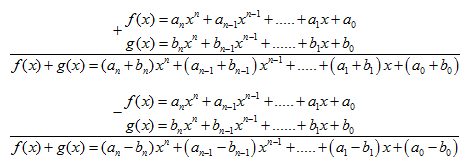Hãy nhập câu hỏi của bạn vào đây, nếu là tài khoản VIP, bạn sẽ được ưu tiên trả lời.

a,f(x)+g(x)=\(\left(a_nx^n+a_{n-1}x^{n-1}+...+a_1x+a_0\right)+\left(b_nx^{n-1}+...+b_1x+b_0\right)\)
=\(a_nx^n+a_{n-1}x^{n-1}+...+a_1x+a_0+b_nx^n+b_{n-1}x^{n-1+...+b_1x+b_0}\)
\(=\left(a_nx^n+b_nx^n\right)+\left(a_{n-1}x^{n-1}+b_{n-1}x^{n-1}\right)+...+\left(a_1x+b_1x\right)+\left(a_0+b_0\right)\)
b
f(x)+g(x)=\(\left(a_nx^n+a_{n-1}x^{n-1}+...+a_1x+a_0\right)+\left(b_nx^n+b_{n-1}x^{n-1}+...+b_1x+b_0\right)\)
\(=a_nx^n+a_{n-1}x^{n-1}+...+a_1x+a_0-b_nx^n-b_{n-1}-b_1x+b_0\)
\(=(a_nx^n-b_nx^n)+(a_{n-1}x^{n-1}-b_{n-1}x^{n-1})+...+(a_1x-b_1x)+\left(a_0+b_0\right)\)
\(=\left(a_n-b_n\right)x^n+(a_{n-1}-b_{n-1})x^{n-1}+...+\left(a_1-b_1\right)x+\left(a_0-b_0\right)\)

a. Ta có: f(x) + h(x) = g(x)
Suy ra: h(x) = g(x) – f(x) = (x4 – x3 + x2 + 5) – (x4 – 3x2 + x – 1)
= x4 – x3 + x2 + 5 – x4 + 3x2 – x + 1
= -x3 + 4x2 – x + 6
b. Ta có: f(x) – h(x) = g(x)
Suy ra: h(x) = f(x) – g(x) = (x4 – 3x2 + x – 1) – (x4 – x3 + x2 + 5)
= x4 – 3x2 + x – 1 – x4 + x3 – x2 – 5
= x3 – 4x2 + x – 6

Bài easy quá mà!
4. a) Áp dụng tỉ dãy số bằng nhau:
\(\frac{a_1-1}{100}=\frac{a_2-2}{99}=...=\frac{a_{100}-100}{1}\)
\(=\frac{\left(a_1+a_2+...+a_{100}\right)-\left(1+2+...+100\right)}{100+99+...+2+1}=\frac{5050}{5050}=1\)
Suy ra: \(a_1-1=100\Leftrightarrow a_1=101\)
\(a_2-2=99\Leftrightarrow a_2=101\)
.......v.v...
\(a_{100}-100=1\Leftrightarrow a_{100}=101\)
Do đó: \(a_1=a_2=a_3=...=a_{100}=101\)
Bài 5/
Theo t/c dãy tỉ số bằng nhau,ta có: \(\frac{y+z-x}{x}=\frac{z+x-y}{y}=\frac{x+y-z}{z}=\frac{2\left(x+y+z\right)}{x+y+z}=2\)\(=\frac{2x}{x}\)
Suy ra:
\(\frac{y+z-x}{x}=\frac{2x}{x}\Leftrightarrow y+z-x=2x\Rightarrow x=y=z\) (vì nếu \(x\ne y\ne z\Rightarrow y+z-x\ne2x\) "không thỏa mãn")
Thay vào A,ta có: \(A=\left(1+\frac{x}{x}\right)\left(1+\frac{y}{y}\right)\left(1+\frac{z}{z}\right)=2.2.2=8\)

Bài 1:
\(M\left(1\right)=a+b+6\)
Mà \(M\left(1\right)=0\)
\(\Rightarrow a+b+6=0\)
\(\Rightarrow a+b=-6\)( * )
\(\Rightarrow2a+2b=-12\) (1)
Ta có: \(M\left(-2\right)=4a-2b+6\)
Mà \(M\left(-2\right)=0\)
\(\Rightarrow4a-2b=-6\)(2)
Lấy (1) cộng (2) ta được:
\(6a=-18\)
\(a=-3\)
Thay a=-3 vào (* ) ta được:
\(b=-3\)
Vậy a=-3 ; b=-3
Bài 2:
a) \(\frac{5}{x}+\frac{y}{4}=\frac{1}{8}\)
\(\Leftrightarrow\frac{1}{8}-\frac{y}{4}=\frac{5}{x}\)
\(\Leftrightarrow\frac{1}{8}-\frac{2y}{8}=\frac{5}{x}\)
\(\Leftrightarrow\frac{1-2y}{8}=\frac{5}{x}\)
\(\Leftrightarrow\left(1-2y\right).x=5.8\)
\(\Leftrightarrow\left(1-2y\right).x=40\)
Vì \(x,y\in Z\Rightarrow1-2y\in Z\)
mà \(40=1.40=40.1=5.8=8.5=\left(-1\right).\left(-40\right)=\left(-40\right).\left(-1\right)=\left(-5\right).\left(-8\right)=\left(-8\right).\left(-5\right)\)
Thử từng TH

\(A=1+3+3^2+3^3+...+3^{99}\)
\(\Rightarrow3A=3+3^2+3^3+...+3^{100}\)
\(\Rightarrow3A-A=2A=\left(3+3^2+3^3+...+3^{100}\right)-\left(\text{}\text{}\text{}1+3^2+3^3+...+3^{99}\right)\)
\(\Rightarrow2A=3^{100}-1\Rightarrow A=\frac{3^{100}-1}{2}\)
